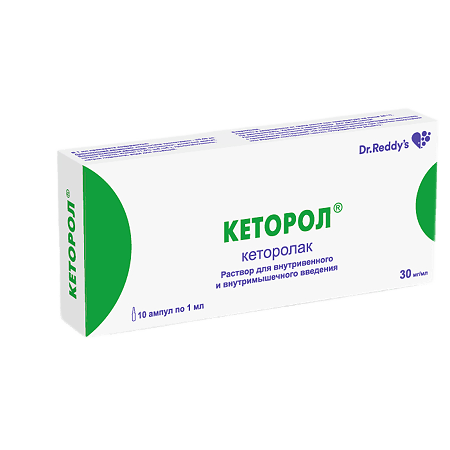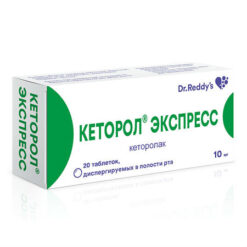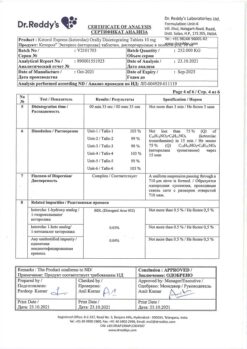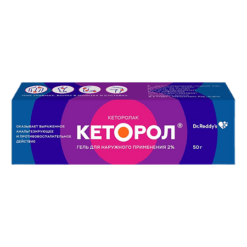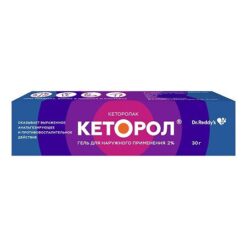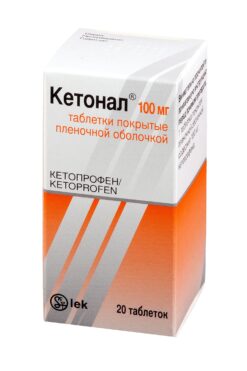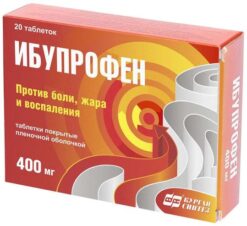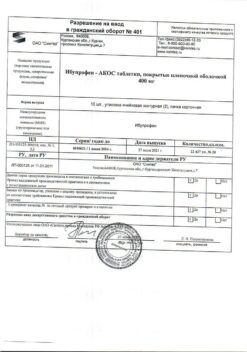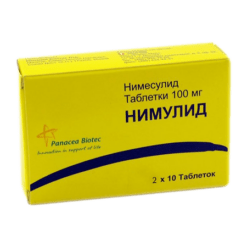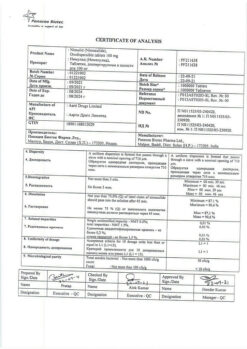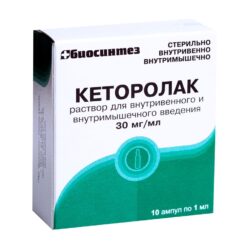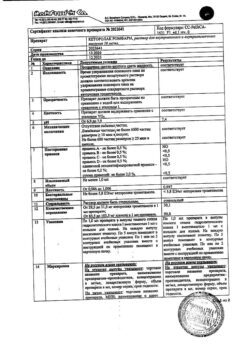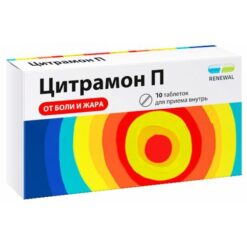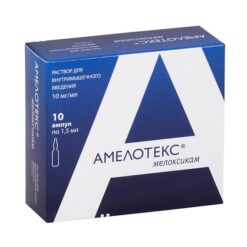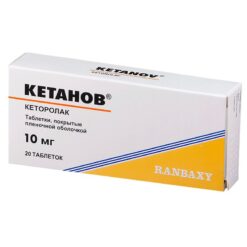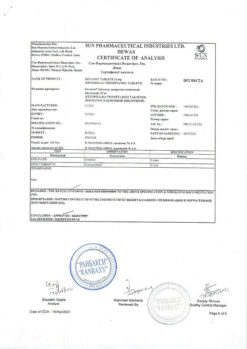No products in the cart.
Ketorol, 30 mg/ml 1 ml 10 pcs
€4.25 €3.78
Description
Pharmacodynamics
Non-steroidal anti-inflammatory drug (NSAID), has a pronounced analgesic effect, anti-inflammatory and moderate antipyretic effect.The mechanism of action is related to non-selective inhibition of cyclooxygenase (COX) – COX-1 and COX-2, catalyzing formation of prostaglandins from arachidonic acid, which play an important role in the pathogenesis of pain, inflammation and fever.
Ketorolac is a racemic mixture of [-]S and [+]R enantiomers, with analgesic effect due to the [-]S form. By the analgesic effect it is comparable with morphine and is superior to other NSAIDs.
The drug does not affect the opioid receptors, does not inhibit respiration, does not cause drug addiction, has no sedative and anxiolytic effects.
Pharmacokinetics
The pharmacokinetics of ketorolac after single and multiple intravenous and intramuscular administration is linear.
When administered intramuscularly absorption is complete and rapid. Maximal concentration of the preparation (Cmax) after intramuscular introduction of 30 mg is 1.74-3.1 µg/ml, after 60 mg – 3.23-5.77 µg/ml; time of reaching the maximum concentration (TCmax) is 15-73 and 30-60 minutes, respectively. Cmax after intravenous administration of 15 mg – 1.96-2.98 mcg/ml, 30 mg – 3.69-5.61 mcg/ml, TCmax – 0.4-1.8 min and 1.1-4.7 min, respectively.
The binding to plasma proteins is 99%. Time of reaching of equilibrium concentration (Css) in parenteral administration of 30 mg 4 times per day – 24 hours; in intramuscular administration of 15 mg – 0.65-1.13 mkg/ml, of 30 mg – 1.29-2.47 mkg/ml.
Distribution volume (Vd) in intramuscular administration – 0.136-0.214 l/kg, in intravenous – 0.166-0.254 l/kg. In patients with renal insufficiency the drug distribution volume may increase twice, and the distribution volume of its R-enantiomer – by 20%.
Indications
Indications
Pain syndrome of strong and moderate severity of various origins due to injuries, toothache, pain in the postoperative period, with oncological and rheumatic diseases, myalgia, arthralgia, neuralgia, radiculitis.
Intended for symptomatic therapy, reducing pain and inflammation at the time of use. Does not affect the progression of the disease.
Pharmacological effect
Pharmacological effect
Pharmacodynamics
A non-steroidal anti-inflammatory drug (NSAID), has a pronounced analgesic effect, has anti-inflammatory and moderate antipyretic effects. The mechanism of action is associated with non-selective inhibition of the activity of cyclooxygenase (COX) – COX-1 and COX-2, which catalyzes the formation of prostaglandins from arachidonic acid, which play an important role in the pathogenesis of pain, inflammation and fever.
Ketorolac is a racemic mixture of [-]S and [+]R enantiomers, and the analgesic effect is due to the [-]S form. The strength of the analgesic effect is comparable to morphine, significantly superior to other NSAIDs.
The drug does not affect opioid receptors, does not depress respiration, does not cause drug dependence, and does not have a sedative or anxiolytic effect.
Pharmacokinetics
The pharmacokinetics of ketorolac after single and repeated intravenous and intramuscular administration is linear.
When administered intramuscularly, absorption is complete and rapid. The maximum concentration of the drug (Cmax) after intramuscular administration of 30 mg is 1.74-3.1 μg/ml, 60 mg is 3.23-5.77 μg/ml, the time to reach the maximum concentration (TCmax) is 15-73 minutes and 30-60 minutes, respectively. Cmax after intravenous administration of 15 mg – 1.96-2.98 µg/ml, 30 mg – 3.69-5.61 µg/ml, TCmax – 0.4-1.8 min and 1.1-4.7 min, respectively.
Communication with plasma proteins – 99%. The time to reach the equilibrium concentration of the drug (Css) with parenteral administration of 30 mg 4 times a day is 24 hours; with intramuscular administration 15 mg – 0.65–1.13 µg/ml, 30 mg – 1.29-2.47 µg/ml.
The volume of distribution (Vd) with intramuscular administration is 0.136-0.214 l/kg, with intravenous administration – 0.166-0.254 l/kg. In patients with renal failure, the volume of distribution of the drug may double, and the volume of distribution of its R-enantiomer may increase by 20%.
Penetrates into breast milk: when the mother takes 10 mg of ketorolac, Cmax in milk is reached 2 hours after taking the first dose and is 7.3 ng/ml, 2 hours after taking the second dose of ketorolac (when using the drug 4 times a day) – 7.9 ng/l. About 10% of ketorolac passes through the placenta.
More than 50% of the administered dose is metabolized in the liver with the formation of pharmacologically inactive metabolites. The main metabolites are glucuronides, which are excreted by the kidneys, and the pharmacologically inactive p-hydroxyketorolac. Excreted 91% by the kidneys, 6% through the intestines.
The half-life (T1/2) in patients with normal renal function is 3.5-9.2 hours after parenteral administration of 30 mg. T1/2 increases in elderly patients and shortens in young ones.
Changes in liver function do not affect T1/2.
In patients with impaired renal function, with a plasma creatinine concentration of 19-50 mg/l (168-442 µmol/l), T1/2 – 10.3-10.8 hours, with more severe renal failure – more than 13.6 hours.
When 30 mg of ketorolac is administered intramuscularly, the total clearance is 0.023 l/h/kg (0.019 l/h/kg in elderly patients); in patients with renal failure (with a plasma creatinine concentration of 19-50 mg/l) – 0.015 l/h/kg. When 30 mg of ketorolac is administered intravenously, the total clearance is 0.03 l/h/kg.
Not excreted by hemodialysis.
Special instructions
Special instructions
Ketorol® has two dosage forms (film-coated tablets and solution for intravenous and intramuscular administration). The choice of method of drug administration depends on the severity of the pain syndrome and the patient’s condition.
Before prescribing the drug, it is necessary to clarify the issue of a previous allergic reaction to the drug or NSAID. Due to the risk of allergic reactions, the first dose is administered under close medical supervision.
Hypovolemia increases the risk of nephrotoxic adverse reactions.
If necessary, can be prescribed in combination with narcotic analgesics.
It is not recommended for use as a drug for prophylactic pain relief, before and during major surgical interventions due to the high risk of bleeding. The drug should not be used together with NSAIDs (including cyclooxygenase-2 inhibitors), since when taken together with other NSAIDs, fluid retention, cardiac decompensation, and increased blood pressure may occur. The effect on platelet aggregation ceases after 24–48 hours.
The drug may change the properties of platelets.
Patients with blood coagulation disorders are prescribed only with constant monitoring of the platelet count, especially important for postoperative patients who require careful monitoring of hemostasis.
The risk of developing drug complications increases with lengthening of treatment (in patients with chronic pain) and increasing the dose of the drug to more than 90 mg/day.
To reduce the risk of adverse events, the minimum effective dose should be used for the shortest possible course.
To reduce the risk of developing NSAID gastropathy, misoprostol and omeprazole are prescribed.
During the treatment period, care must be taken when driving vehicles and engaging in other potentially hazardous activities that require increased concentration and speed of psychomotor reactions.
Active ingredient
Active ingredient
Ketorolac
Composition
Composition
1 ml of solution contains:
active ingredient:
Contraindications
Contraindications
Hypersensitivity to ketorolac;
complete or incomplete combination of bronchial asthma, recurrent polyposis of the nose or paranasal sinuses and intolerance to acetylsalicylic acid and other NSAIDs (including a history);
erosive and ulcerative changes in the mucous membrane of the stomach and duodenum, active gastrointestinal bleeding; cerebrovascular or other bleeding;
inflammatory bowel diseases (Crohn’s disease, ulcerative colitis) in the acute phase;
hemophilia and other bleeding disorders;
decompensated heart failure;
liver failure or active liver disease;
severe renal failure (creatinine clearance less than 30 ml/min), progressive kidney disease, confirmed hyperkalemia;
postoperative period after coronary artery bypass surgery;
simultaneous use with probenecid, pentoxifylline, acetylsalicylic acid and other NSAIDs (including cyclooxygenase-2 inhibitors), lithium salts, anticoagulants (including warfarin and heparin);
the drug is not used for prophylactic pain relief before and during major surgical interventions due to the high risk of bleeding;
pregnancy, childbirth, lactation;
children under 16 years of age (safety and effectiveness have not been established).
With caution:
Bronchial asthma, coronary heart disease, congestive heart failure, edema syndrome, arterial hypertension, cerebrovascular diseases, pathological dyslipidemia or hyperlipidemia, renal dysfunction (creatinine clearance 30-60 ml/l), diabetes mellitus, cholestasis, sepsis, systemic lupus erythematosus,
peripheral arterial disease, smoking, old age (over 65 years), anamnestic data on the development of ulcerative lesions of the gastrointestinal tract, alcohol abuse, severe somatic diseases, concomitant therapy with the following drugs: antiplatelet agents (for example, clopidogrel), oral glucocorticosteroids (for example, prednisolone), selective serotonin reuptake inhibitors (for example, citalopram, fluoxetine, paroxetine, sertraline).
Side Effects
Side Effects
The frequency of side effects is classified depending on the frequency of occurrence of the case: often (1-10%), sometimes (0.1-1%), rarely (0.01-0.1%), very rarely (less than 0.01%), including individual reports.
From the digestive system: often (especially in elderly patients over 65 years of age with a history of erosive and ulcerative lesions of the gastrointestinal tract) – gastralgia, diarrhea; less often – stomatitis, flatulence, constipation, vomiting, feeling of fullness in the stomach; rarely – nausea, erosive and ulcerative lesions of the gastrointestinal tract (including with perforation and/or bleeding – abdominal pain, spasm or burning in the epigastric region, melena, vomiting like “coffee grounds”, nausea, heartburn and others), cholestatic jaundice, hepatitis, hepatomegaly, acute pancreatitis.
From the urinary system: rarely – acute renal failure, lower back pain with or without hematuria and/or azotemia, hemolytic-uremic syndrome (hemolytic anemia, renal failure, thrombocytopenia, purpura), frequent urination, increased or decreased urine volume, nephritis, edema of renal origin.
From the senses: rarely – hearing loss, ringing in the ears, visual impairment (including blurred visual perception).
From the respiratory system: rarely – bronchospasm, rhinitis, laryngeal edema (shortness of breath, difficulty breathing).
From the central nervous system: often – headache, dizziness, drowsiness; rarely – aseptic meningitis (fever, severe headache, convulsions, stiffness of the neck and/or back muscles), hyperactivity (mood changes, anxiety), hallucinations, depression, psychosis.
From the cardiovascular system: less often – increased blood pressure; rarely – pulmonary edema, fainting.
From the hematopoietic organs: rarely – anemia, eosinophilia, leukopenia.
From the hemostasis system: rarely – bleeding from a postoperative wound, nosebleeds, rectal bleeding.
From the skin: less often – skin rash (including maculopapular rash), purpura; rarely – exfoliative dermatitis (fever with or without chills, redness, thickening or flaking of the skin, swelling and/or tenderness of the tonsils), urticaria, Stevens-Johnson syndrome, Lyell’s syndrome.
Local reactions: less often – burning or pain at the injection site.
Allergic reactions: rarely – anaphylaxis or anaphylactoid reactions (change in facial skin color, skin rash, urticaria, itching of the skin, shortness of breath, swelling of the eyelids, periorbital edema, difficulty breathing, heaviness in the chest, wheezing).
Other: often – swelling (face, legs, ankles, fingers, feet, weight gain); less often – increased sweating; rarely – swelling of the tongue, fever.
Interaction
Interaction
The simultaneous use of ketorolac with acetylsalicylic acid or other NSAIDs, calcium preparations, corticosteroids, ethanol, corticotropin can lead to the formation of gastrointestinal ulcers and the development of gastrointestinal bleeding.
The drug should not be used simultaneously with other NSAIDs.
Co-administration with paracetamol increases nephrotoxicity, and with methotrexate – hepato- and nephrotoxicity.
The simultaneous administration of ketorolac and methotrexate is possible only when using low doses of the latter (it is necessary to monitor the concentration of methotrexate in the blood plasma).
Probenecid reduces the plasma clearance and Vd of ketorolac, increases its concentration in the blood plasma and increases T1/2.
With the use of ketorolac, the clearance of methotrexate and lithium may decrease and the toxicity of these substances may increase.
Co-administration with indirect anticoagulants, heparin, thrombolytics, antiplatelet agents, cefoperazone, cefotetan and pentoxifylline increases the risk of bleeding.
Reduces the effect of antihypertensive and diuretic drugs (PG synthesis in the kidneys decreases).
When combined with narcotic analgesics, the doses of the latter can be significantly reduced.
Antacids do not affect the complete absorption of the drug.
Increases the hypoglycemic effect of insulin and oral hypoglycemic drugs (dose recalculation is necessary).
Co-administration with valproic acid causes disruption of platelet aggregation.
Increases the plasma concentration of verapamil and nifedipine.
When prescribed with other nephrotoxic drugs (including gold preparations), the risk of developing nephrotoxicity increases. Drugs that block tubular secretion reduce the clearance of ketorolac and increase its concentration in the blood plasma.
Overdose
Overdose
Symptoms: abdominal pain, nausea, vomiting, erosive and ulcerative lesions of the gastrointestinal tract, impaired renal function, metabolic acidosis.
Treatment: gastric lavage, administration of adsorbents (activated carbon) and symptomatic therapy (maintaining vital body functions). Not eliminated sufficiently by dialysis.
Storage conditions
Storage conditions
In a place protected from light at a temperature not exceeding 25 ° C.
Do not freeze.
Keep out of the reach of children!
Shelf life
Shelf life
3 years
Manufacturer
Manufacturer
Dr. Reddy’s Laboratories Ltd, India
Additional information
| Shelf life | 3 years |
|---|---|
| Conditions of storage | In the dark place at a temperature not exceeding 25 ° C. Do not freeze. Keep out of reach of children! |
| Manufacturer | Dr. Reddy's, India |
| Medication form | solution |
| Brand | Dr. Reddy's |
Other forms…
Related products
Buy Ketorol, 30 mg/ml 1 ml 10 pcs with delivery to USA, UK, Europe and over 120 other countries.

